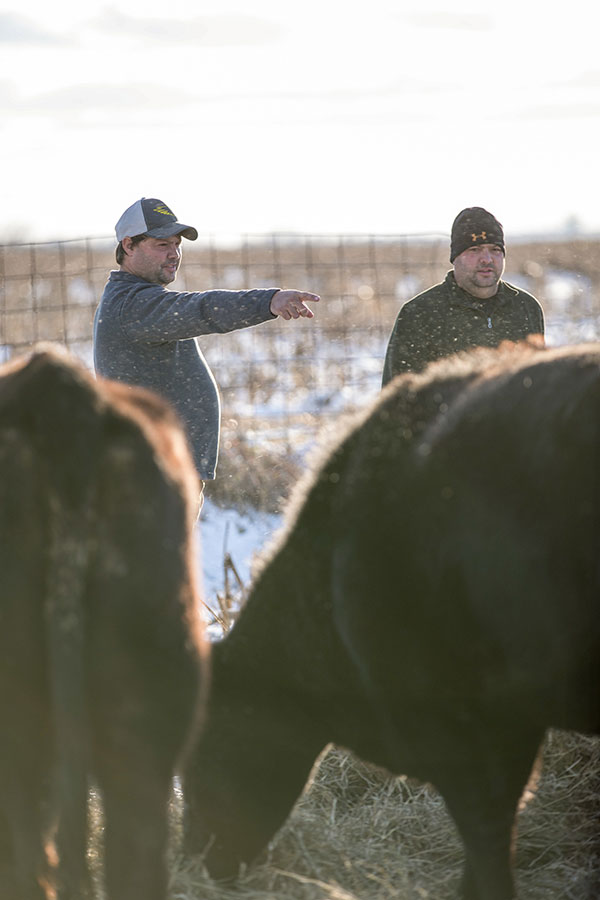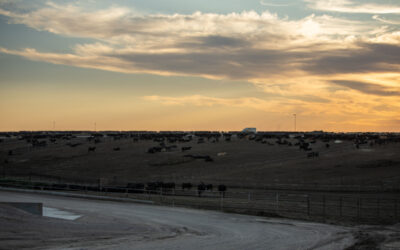
Sights set on better beef
Decades of dedication to carcass quality help commercial ranchers rise to the top.
By: Nicole Lane Erceg
It didn’t happen overnight. Nearly 20 years ago, brothers Aaron and Darin Georg set out to raise the best Angus cattle they could breed.
“We figured, if you’re going to raise Angus, it better be quality,” Aaron remembers.
As the brothers finished the calves at their own yard near Sabetha, Kan., they watched the data as numbers got better and better.
Lately, they’ve switched to having them custom fed at Weber Feedyards, Dorchester, Neb., where the trend continues. Just last year, the best they’ve ever raised earned Reserve Champion in the Certified Angus Beef ® (CAB®) Angus Value Discovery Contest.
That pen of 42 steers achieved 97.6% CAB (all but one), including 61.9% CAB brand Prime. One feature that made them stand out and all but win the top rung was only one had to take a yield grade (YG) 4 discount, with no YG 5s.
It’s common to see 10% or more YG4s in the industry, but not in the Georg cattle. The combination of leanness with premium quality is common here.
Carcass data is a key indicator of performance for their herd. They regularly see loads grade 30% or more Prime as they target improved growth and efficiency. Watching the closeouts, the brothers work to see ever fewer YG 4s with continued increases in Prime.
“We select for carcass merit because that’s where the value is,” Aaron says.
Following the money
“Some years the premiums are all we make on these calves, so we’ve got to make sure we capture those premiums,” Darin says.
A banker before his fulltime farming days, Darin is a student of the numbers. He says examining cash flows and being on the other side of the desk on loan applications taught him the value of knowing where every dollar goes.
Never having marketed their calves at weaning, the brothers can’t fathom turning back.
“If you have cattle that can perform, we believe it’s in our best interest to retain them and capture the value,” Darin says.
“You have to understand how the producer gets paid and what they are paying you for,” says Aaron. “They’re looking at yield and quality grades so you bet we pay attention to yield and quality grades.”
Their understanding of the flow of dollars and the genetics behind their calves instills confidence in their current model.
“I understand the exact cost of every cow,” he says. “It’s a balance of expenses and income and I’m not going to keep around an unworthy expense.”
Together, they weigh the trade-offs and trust the data to lead them in the right direction.
Sons of teachers, they value humble beginnings and the hard work it takes to build something that lasts. It was their parents who purchased the original land to begin farming, and today it supports all three families, includes a 500-head cowherd and 2,000 acres of row crops in the rolling hills of northeast Kansas.
“We’ve been doing this for 20 years, going towards the same goal in the same direction,” says Aaron. “Everything takes time.”
Priorities
When they recognize weaknesses, the brothers address them head on.
“There was a time we were calf-pulling professionals,” Aaron laughs at the memory. “I don’t remember the last time we pulled one out of a cow and it’s been at least three years since we’ve pulled out of a heifer.”
They say the Angus breed is known for two things: carcass quality and good mothering ability. They ensure their herd includes both.
“The female accounts for 50% of those genetics, so you have to have a strong female base if you’re going to raise a good-grading calf,” says Darin.
No cow on their place makes it past the decade mark.
Their 10-year cow rule doesn’t mean the underperforming get a place in the pasture. Each animal is analyzed for any reason she might not raise a quality calf. They look at her genetics, the pasture quality, her health. If the reason is determined non-environmental, she doesn’t stick around.
“We know our exact costs in every cow and every calf,” says Aaron.
“I’m not married to any of them, so if she is not performing, I have no problem loading her up in the trailer and taking her to town,” says Darin. “You’ve got to run this like a business, because it is.”
Heifer selection criteria is just as strict. The brothers make an initial cut of 100, which have a month to prove themselves before the final selection is whittled down to the 65 that get to stay. They’re looking for growth, feed efficiency, health and structure to go with the proven genetic ability to raise cattle that grade.

Steady progress
Bulls are sourced from nearby Effingham, Kan., breeder Keith Taliaferro at T Bar T Angus ranch.
When you’re playing the long game, consistency is key. For years the brothers focused selection criteria on marbling and ribeye area. Today, growth and weaning weight take higher priority, but only because there are decades of quality-carcass genetics built into their females.
“One bull won’t wreck your entire program, but you can’t take your eye off the main goal,” says Darin. “We’re trying to add more growth into our calves so we are focused on that, but it doesn’t mean we ignore other important genetic factors like cow performance or marbling.”
“Understand you can’t do everything all at once,” says Aaron. “Know your weaknesses and work on them.”
Slow, steady progress. One step at a time.
“We want to have something to show for our work,” says Darin. “We’re proud of how we’ve been able to grow and the progress we’ve seen, but to keep this around for the next generation we need to continue to get better.”
They stay on course and cull deep, always trying to stay ahead of the industry.
“Many people still don’t understand that 75% Choice is average. We refuse to be average,” says Aaron.
“A Choice, YG 3 carcass is par for the course,” Darin adds. “We’ve got to consistently do better than that.”
It’s a goal their family has been targeting for decades, now justifiably proud of the progress.
“Set a goal of what you want to obtain, make it realistic and stick to the plan,” Darin advises other producers. “It’s going to take years, but when you see the results it’s easier to keep on the track.”
To which his brother flippantly adds, “And don’t go broke!”
Originally ran in the Angus Journal.
You May Also Like…
Every Issue Has Its Moment
Progress happens when people are at the table, engaged and committed to action. With a vested interest in the industry’s future, CAB is leaning in on conversations surrounding evolutions in meat science.
Thriving with Shrinking Supply
Even as the nation’s cow herd contracts, “more pounds” and “higher quality” have been common themes. Specific to commercial cattlemen: It still pays to focus on carcass merit, in addition to other economically relevant traits.
Prime Trends Up
As Prime supplies leapt higher in 2018, continually increasing, the retail grocery sector woke up to the fact that Prime beef cuts could be accessed dependably throughout the year. Prime was no longer reserved for only the high-end restaurant customer. Simply put, creating availability at the grocery level unlocked consumer demand where it hadn’t been tapped before.




